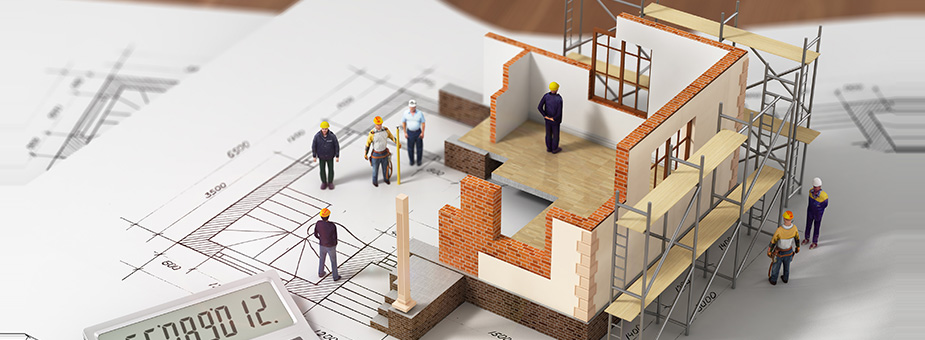HOME LOAN GUIDE
Introduction
Everyone dreams of owning a house. It is considered to be one of the three necessities of life: Roti (bread), Kapada (Clothing), and Makkan (House) in that order. Once you complete your studies, take up a job, and get married, you start dreaming about your own house as you would have met or got the confidence that you would be able to meet the first two needs. However, building or buying a home of your own would be one of the major decisions you will be making in your life. This is because you will be making a long-term financial commitment.
Deciding to go in for your own home is an important decision in your life as it forms part of your goal to secure your family’s future. That said, most people in India would need some kind of financial assistance to help them fructify their dream. To cater to this need, many banks and other financial institutions in India extend home loans to eligible individuals.
If you are planning to buy a new home, you must have a clear idea about home loans and mortgages to make an informed decision. Simple mistakes that many people make can cost them a great deal of money over the term of the loan that often runs into 20 to 30 years. This home loan guide will take you through all the aspects you need to know before applying for a home loan and buying a home for yourself. So, let us get started.

A home loan can be defined as the amount of money borrowed by an individual from either a bank or a financial institution at a specified rate of interest. The money borrowed should be paid back based on equated monthly installments (EMI) within the agreed period. Often, the borrower offers the property as collateral security for the money advanced by the lender for buying the home. The property may be personal or commercial. If the borrower fails to repay the loan amount, the lender can legally recover the outstanding amount by selling the property that was offered as collateral security.
Though availing a home loan is a long term financial commitment, it does offer some benefits. Some of them are listed below:
HOME LOAN GUIDE
Types of Home Loans In India
Since home loans are a popular way of financing the purchase of a home in India, a number of different types of home loans are offered by lenders. Over the last 10 years, the demand for home loans has increased tremendously. That said, the popular types of home loans in India are:
This is the most commonly available home loan in India. You can avail a home loan to buy a new under-construction property, ready-to-move-in unit, or a home that is put up for resale. Based on your income profile and capacity to repay, the lender may extend a loan ranging anywhere from Rs. 2 lakh to Rs. 200 lakh. Typically, lenders provide financial assistance to the tune of 85 percent of the current market value of the house you are planning to buy.
 Tips:
Tips:

Banks provide land purchase loans for buying residential plots that are located within the corporation or municipality limits. The approval processes and interest rates involved are similar to that of the home loan. However, the maximum limit for Loan To Value is 70 percent of the value of the plot you are planning to buy. The maximum loan repayment period allowed is 15 years.
 Tips:
Tips:

If you are looking to construct a house instead of buying a ready-to-occupy unit, then you should apply for a home construction loan. The loan application form and the approval procedure involved in the case of home construction loans are different from that for other types of housing finance. You have to prepare a plan and provide a rough estimate of the cost of constructing the house as per the plan when applying for a house construction loan. Further, you should have bought the piece of land where the house will be built within a year. The lender approves a loan amount and disburses the same either at one-go, or in stages, based on the progress in construction, loan size, and LTV applicable in your specific case.
 Tips:
Tips:

If you already own a home and want to expand it or add a balcony or enclose a balcony, build one more bedroom, expand the bathroom, or remodel a room, then you should seek this type of home loan. Generally, lenders fund up to 70 to 85 percent of the estimated value of the extension work. Loan is sanctioned taking into consideration your age, creditworthiness, credit history, and repayment capacity. You can choose either a floating or fixed interest rate. Typically, the tenure of the loan is 15 years. You must be at least twenty-one years old if you want to apply for this loan. The maximum age is your retirement age.
 Tips:
Tips:
You might have already taken a home loan and bought a home using the same. However, you may now wish to buy and move to another new house. In such a situation, you can apply for a home conversion loan. The lender may transfer your existing loan to your new house. After the transfer, you are not required to repay the old home loan. It offers convenience, but this home loan variant is very expensive.
 Tips:
Tips:
You might already be having a home, but you may not have sufficient funds for renovation work. This home loan variant enables you to carry out internal/external painting work, repairs, waterproofing, construction of underground/overhead water tank, electrical work, etc.
 Tips:
Tips:
The NRI home loan is a specially designed home loan variant for supporting non-resident Indians that want to buy a residential property in their home country. The application procedure and compliance aspects related to availing this type of home loan are different from that of others. In general, most of the public and private sector banks extend NRI home loans.
 Tips:
Tips:
The balance transfer loan is for you if you wish to transfer the home loan you have obtained from one bank to another bank. Typically, this home loan variant allows you to take advantage of the reduction in interest rates for home loans.
 Tips:
Tips:
You can apply for a loan to pay the stamp duty charges applicable for registration of your home. The property must have been purchased by you. Some banks provide this type of home loan. This is not a very widely known home loan variant.
A bridged loan is a short-term loan. It is designed to help existing homeowners that want to buy a new property. This home loan variant enables borrowers to obtain funds for purchasing a new house till they identify a buyer for their existing property. You may have to mortgage the new house with the lender when availing this loan. Typically, the tenure of a bridged loan is less than two years. Home loans have become the norm for buying a home. It is, therefore, important that you identify your requirement properly and ensure that you apply for and get the type of home loan that best suits you. It will not only reduce the paperwork but also simplify the approval process. In addition, you will be better equipped to avail a loan at a reduced interest rate. Finally, make use of a home loan calculator that helps you to determine the EMI. This will enable you to understand the amortization schedule better and plan your finances.
HOME LOAN GUIDE
Eligibility Criteria, Credit Score and Documents Required
Buying your own house through a home loan comes with tax benefits. This helps you to manage cash flow along with reduction of taxes. You can decide the type of home loan you want. However, it pays to be in the know of your home loan eligibility and the criteria to be satisfied prior to applying for one. You can use the home loan funds for purposes such as new house construction, purchase of a new/used house, or renovation. Irrespective of your occupation/profession, it is important that you check your home loan eligibility through the online calculator available in this home loan guide prior to approaching a bank or other financial institution.
Banks and financial institutions that offer home loans will look at several criteria before sanctioning the loan. Some of the common and important ones are listed below for your ready reference:
Apart from the above, some of the other criteria that the lenders often take into consideration are:

This is one of the crucial aspects that lenders take into consideration. If you belong to the salaried class, you should be employed for a period of two years in the present organization. If you are self-employed, then you should have been earning an income for a minimum of five years. If you do not satisfy this criterion, your loan application will not be considered at all.
If you are employed in a company that has a high reputation and market standing, your credibility will be much better.
Apart from your company’s performance, your credit score is also important. The higher your credit score, the higher the chances of you obtaining a loan with better terms. Defaults in payment history, not-so-good payment track record, and outstanding loans can all negatively impact your credit score. The bank may even cancel the loan request or charge a higher rate of interest.
What is Credit Score?If you are wondering as to “what is a credit score”, it is a statistical number. It evaluates an individual’s creditworthiness. It is based on a person’s credit history. Lenders often make use of credit scores for evaluating the probability of an individual repaying his/her debts. The credit score of an individual can range from 300 to 850. The higher you score, the more trustworthy you are. In India, lenders check your CIBIL score prior to approving a loan. TransUnion CIBIL Limited, the credit information provider in India, maintains credit records of 32 million businesses and 600 million individuals. It is one of the four credit bureaus that operates in India and belongs to the American multinational group TansUnion.

When it comes to assessing your financial situation, the lenders take into consideration your present status and your track record with respect to financial stability.
 Tips:
Tips:
When you are applying for a home loan, the first question that comes to your mind is “how much home loan can I get on my salary?” The home loan eligibility calculator that is included in this guide will help you to get a fair idea as regards how much you can get. The calculator determines the amount by considering the following factors:
Use our easy to access Home Loan Eligibility calculator to help you plan for your dream faster and more efficiently.
Calculate NowWhen applying for a home loan, you are required to submit a host of documents as listed below:
Salaried individuals (any one of the documents listed below)
In addition, salaried individuals are required to furnish investment proofs such as fixed deposits, share certificates, etc., and passport-size photographs.
6.0 Self-employed individuals/businessman (any one of the documents listed below)This is not an exhaustive list of documents to be submitted when applying for a home loan. The documents required for home loan approval often varies from one lender to another.
HOME LOAN GUIDE
Pradhan Mantri Awas Yojana (PMAY)
The Pradhan Mantri Awas Yojana housing for all urban area envisages that everyone will have a home by 2022. The scheme was launched in 2015 by the central government with a view to ensure housing to all of the urban people by the year 2022. One of the key features of PMAY is the credit-linked subsidy scheme. This means that interest subsidy is extended to the beneficiaries as and when they take a housing loan. The scheme also envisages central assistance to both states and union territories that focus on building houses for all eligible sections of people in urban slums, especially the economically weaker sections. Therefore, the major features of the project are slum rehabilitation and making available affordable housing to the people belonging to economically weaker sections. In urban areas, interest subsidy is extended to three types of income groups. They are as follows:
|
Subsidy for Economically Weaker Sections
(Annual per capita income less than Rs. 300,000) |
6.5 percent |
|
Subsidy for Low Income Group
(Annual per capita income ranging from Rs. 300,001 to Rs. 600,000) |
6.5 percent |
|
Middle Income Group I
(Annual per capita income ranging from Rs. 600,001 to Rs. 1,200,000) |
4.0 percent |
|
Middle Income Group II
(Annual per capita income ranging from Rs. 1,200,000 to Rs. 1,800,000) |
3.0 percent |
On the basis of their pradhan mantri awas yojana eligibility, credit-linked subsidies will be extended to these categories of people. People belonging to the low per capita income category will get higher interest subsidy. The programme offers the following components or options to the cities and towns in states and union territories:
As per the provisions of the programme, the house constructed for the people belonging to the economically weaker sections shall be all-weather single units or one unit in a multi-storeyed building. There should be adequate basic civic amenities. Infrastructure amenities should include toilets, water, electricity, etc. States have the freedom to choose the area as per local needs.
Credit-linked interest subsidy of 6.50 percent is provided by the Government of India for the actual term of the loan or 20 years, whichever is lower, to eligible people belonging to the EWS/LIG category. The subsidy is, however, limited to a maximum of Rs. 267,000.
The central government provides an assistance of Rs. 150,000 per house for beneficiaries belonging to the EWS category. State Governments/affiliates, for instance, Housing Boards, might take up affordable housing projects and avail the Central Government grant.
MIGThe Credit-Linked Subsidy Scheme, in short CLSS, launched by the Government of India under the auspices of the Housing and Urban Poverty Alleviation Ministry for the MIG beneficiaries was initially implemented for a year (01.01.2017 to 31.12.2017). However, it has now been extended till 31.03.2019.
Other key points to be noted as far as PMAY is concerned are:
 Tips:
Tips:
HOME LOAN GUIDE
Home Loan Agreement and Important Clauses
Once your application for a home loan is approved by the bank following verification of documents, you need to execute a home loan agreement with the lender. The home loan agreement, a legal document, clearly specifies the terms and conditions for advancing money for house construction and mortgaging the home in favour of the lender. As a borrower, you need to have clear idea of some of the important clauses included in the mortgage agreement prior to putting your signature on the dotted line. Most home buyers consider signing an agreement as just a formality. It is not true. It is a key legal document and it specifies the rights as well as liabilities of the borrower. Some clauses in the home loan agreement can hurt home buyers in a big way. The important clauses in a loan agreement that you must definitely go through and understand clearly are as follows:
This is a very dangerous clause and it often works completely against your interests as the borrower. This is because the bank often retains the power to change the agreement if you happen to face any kind of difficulty in repaying the loan and release the mortgage on the property. You must make sure that your written consent is sought for altering any of the terms or conditions of the mortgage agreement you have entered into with the lender.

The provisions in the fluctuating interest rates clause empower the lender to change the payable interest rate based on a hike or reductions in the base rate that is applicable. Banks raise the interest rate when there is an increase in the market rate. When the interest rate keeps fluctuating, fixed rate loans often get converted to floating or variable rate loans. It is, therefore, important that you carefully read through the loan agreement to ensure that the terms related to the interest rate that have been negotiated are captured and incorporated in the agreement.
The provisions of this clause could work against the trust placed by the borrower on the lender. This is because as a borrower you agreed to deal with the bank that has provided the home loan but you may end up dealing or communicating with other parties. Many banks, non-banking financial companies, and home loan finance companies include this clause in the loan agreement which gives them the authority to share your details, even post-dated cheques, with a third party, without providing prior information to you, for the purpose of recovery in the event of a default in payment from your side. Many borrowers may not even be aware of this. You get annoyed when debt collection agents call you to collect the defaulted EMIs.

This clause empowers the lending bank to demand for more security if the property prices happen to fall. This demand is put forward by the lender irrespective of whether you have been very loyal with respect to your EMI payments or not. The bank demands a security cover that is higher in value than the home loan given to you. If you fail to provide the security cover as demanded, then you may be deemed to be a defaulter by the bank. In this clause, the banks normally mention that they are entitled to declare the amount outstanding under the loan (inclusive of the principal, interest, expenses, and charges) and it is immediately payable in the event of depreciation in the value of the security or the property itself.
It is in this clause that the conditions under which you could be considered to be a defaulter are specified. The implications of becoming a defaulter will also be clearly spelt out.
As far as a lay person is concerned, default often means not paying an EMI on time during the tenure of the home loan. However, the banks and other housing finance companies define default in a different manner. Some home loan finance providers define default in such a way that in the event of the death of the borrower or the borrower becoming a divorcee the loan gets extended to include more than one person.
Default might also mean a situation wherein a borrower or one of the borrowers gets involved in any kind of criminal offence or civil litigation. Therefore, it is very important that you clarify with the lender as to what they really mean by the term default.
The home loan agreement drafted by most banks and home loan financiers is likely to have this clause. It may have loopholes that allow the lender to increase the fixed interest rate if certain exceptional circumstances prevail. It is not easy to define the exceptional circumstances in a clear manner. However, if you scrutinise the agreement properly, you will be able to avoid ending up with a semi-fixed rate loan after starting off as a fixed rate loan.

The sanctioned home loan amount may not always be disbursed to you directly. Banks disburse home loans as per the provisions in the disbursement clause. If the clause says that it will be directly disbursed to the housing provider, then the payment will be made to the builder directly. In the case of balance transfer, the amount will be transferred to the other bank directly by your bank.
The payments being made by you in the beginning would be adjusted or offset against other dues, if any, that are outstanding as on that specific date.
You are obliged to inform the lender any change in your employment, business, profession, address, income levels, and residential status. A mortgage agreement is not just a formality. Experts are of the opinion that you should never make haste in signing the agreement. In order to bag a good deal, you must, at the outset, negotiate all of the terms and conditions that form part of the home loan agreement, including the amount being sanctioned and the applicable interest rate.
What can you do if you feel that a clause in the home loan agreement is not appropriate? CEO of Muthoot Homefin India Ltd. opines that clauses in a mortgage agreement have legal implications and that they need to be clearly understood and complied with for the smooth execution of the agreement. It is, therefore, highly recommended that you go through your home loan agreement thoroughly. If you determine that some of the clauses are either not clear or inappropriate, you should get the same clarified by the lender prior to signing the agreement. Alternatively, you can seek a legal professional’s help who would represent you during the negotiation with the lender.
HOME LOAN GUIDE
Home Loan Prepayment & conclusion
As an individual, you would always want to be free of any debt. It is this feeling that encourages you to consider repayment of your home loan as early as possible. The prepayment clause in your home loan agreement allows you to pay off the outstanding balance in the event of you having some amount of surplus funds with you prior to the end of the loan tenure. You can repay the housing loan either in part or in full. If you make a part payment, the outstanding principal reduces and the EMI or the loan tenure decreases.
Home loan prepayment is a good idea, but some of the aspects that you need to take into account prior to prepaying the loan are as follows:
Most lenders specify a prepayment penalty, the fee/charge that you should to pay if you want to repay the loan before the completion of its tenure. You may prepay the loan with the funds you have in your savings account or by transferring the loan to another bank so that you can enjoy a lower interest rate. Lenders charge a fee for early repayment because they will be losing out on their interest income.
As regards the home loan prepayment rules, the Reserve Bank of India (RBI) issued a circular in 2014 stating the prepayment rules for lenders. The National Housing Bank has communicated the same to banks and housing finance companies (HFCs). These are as follows:
Banks and HFCs cannot charge any prepayment fee in the following situations:
As per RBI rules, banks can charge prepayment penalty only on the loan amount that is outstanding. Typically, the prepayment penalty is 2 to 3 percent of balance outstanding at the time of prepayment.

 Tips:
Tips:
One of the key home loan prepayment advantages is a reduction in the interest burden. This, in turn, brings down the cost of your house. However, it can turn out to be tricky if you are not well informed of the formalities involved and charges payable. Getting rid of the liabilities might seem attractive when you get some extra money through a pay hike, promotion, or new job, but you should consider a few things before prepayment:
Most people in India need to avail a home loan to fulfil their dream of having their own residence. There are advantages and disadvantages to availing a home loan. While a couple of advantages are tax benefits and capital appreciation, the main disadvantage is that it is a long-term financial commitment. Therefore, you should choose your home loan wisely by developing a clear understanding as to what it entails. You should put in some amount of effort for this purpose. If you are a busy person, you could start your research by going through this home loan guide which touches upon all of the key aspects related to home loans in brief. Ultimately, you have to decide your budget, based on your specific needs, and borrow an amount that you will be able to repay without any hassles.